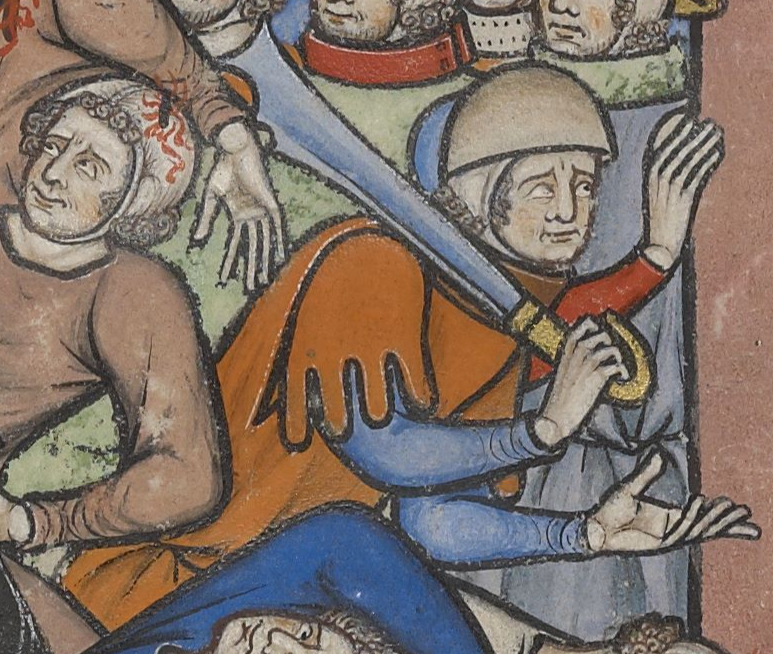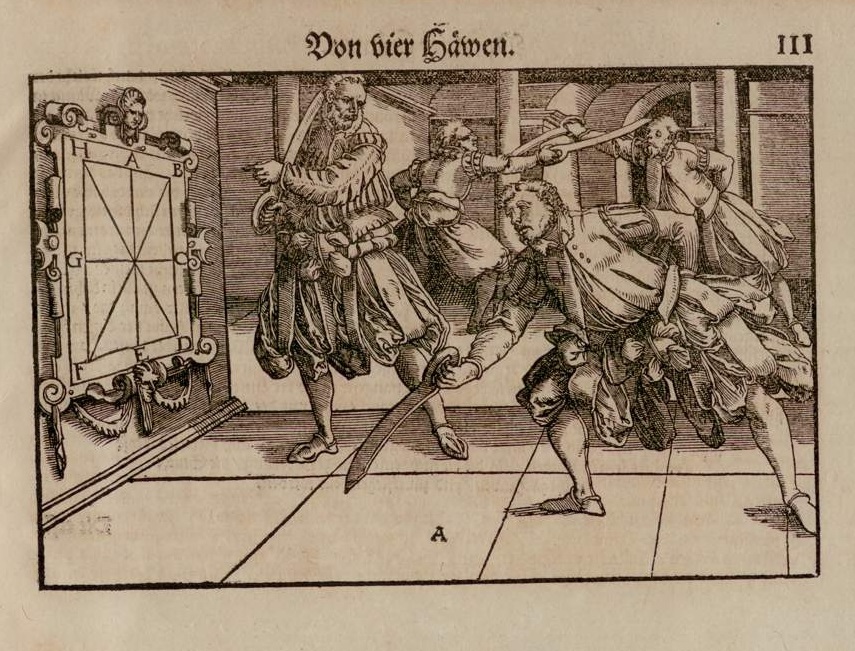|
Falchion
A falchion (; Old French: ''fauchon''; Latin: ''falx'', "sickle") is a one-handed, backsword, single-edged sword of European origin. Falchions are found in different forms from around the 13th century up to and including the 16th century. In some versions, the falchion looks rather like the seax and later the sabre, and in other versions more like a machete with a crossguard. Types The blade designs of falchions varied widely across the continent and over time. They almost always included a single edge with a slight curve on the blade towards the point on the end and most were also affixed with a quilloned crossguard for the hilt in the manner of the contemporary arming swords. Unlike the double-edged swords of Europe, few actual swords of this type have survived to the present day; fewer than a dozen specimens are currently known. A number of weapons similar to the falchion existed in Western Europe, including the Messer (weapon), Messer, hanger (weapon), hanger and the backs ... [...More Info...] [...Related Items...] OR: [Wikipedia] [Google] [Baidu] [Amazon] |
Elmslie Typology
The Elmslie typology is a system for classification and description of the single edged European bladed weapons of the late medieval and early baroque period, from around 1100 to 1550. It is designed to provide classification terminology for archaeological finds of single-edged arms, as well as visual depictions in art. It includes swords which are from the Europeans Middle Ages (approximately 11th through 16th centuries) and currently breaks them down into five main types, which each have several subtypes. Historian and bladesmith James Elmslie introduced the typology 2015, as a complement to the Oakeshott typology which covers double edged swords of the same periods. Criteria of definition Criteria for the typology were, in order of priority: That it should be simple enough for the basic system to be learnt and remembered without needing constant reference to the published source. That it should be possible to apply both to hands-on analysis of archaeological objects, and to ... [...More Info...] [...Related Items...] OR: [Wikipedia] [Google] [Baidu] [Amazon] |
Sabre
A sabre or saber ( ) is a type of backsword with a curved blade associated with the light cavalry of the Early Modern warfare, early modern and Napoleonic period, Napoleonic periods. Originally associated with Central European cavalry such as the hussars, the sabre became widespread in Western Europe during the Thirty Years' War. Lighter sabres also became popular with infantry of the early 17th century. In the 19th century, models with less curving blades became common and were also used by heavy cavalry. The military sabre was used as a duelling weapon in academic fencing in the 19th century, giving rise to a discipline of modern Sabre (fencing), sabre fencing (introduced in the Fencing at the 1896 Summer Olympics, 1896 Summer Olympics) loosely based on the characteristics of the historical weapon. Etymology The English ''sabre'' is recorded from the 1670s, as a direct loan from French, where ''sabre'' is an alteration of ''sable'', which was in turn loaned from German ''S ... [...More Info...] [...Related Items...] OR: [Wikipedia] [Google] [Baidu] [Amazon] |
Messer (weapon)
A messer (German for "knife") is a single-edged sword of the 15th and 16th century, characterised by knife-like hilt construction methods. While the various names are often used synonymously, messers can be divided into several principal groups: A ''Bauernwehr'' ("peasant's knife" or "peasant's sidearm") or ''Hauswehr'' ("home/household knife") is a single-handed knife, used for utility and defence. Typical blade lengths range from lengths up to around . ''Messer'', ''Langes Messer'', and ''Großes Messer'' ("knife", "long knife", and "great knife" respectively) are usually single-handed swords used for self-defence. These blade lengths ranged from about to . Hilts are normally suited to single handed use, but the larger examples may feature extended grips suitable for a second hand-hold. ''Kriegsmesser'' ("war knife") are the largest examples of messer-hilted weapons, ranging from around long with approximately blade, up to around long with blades up to in length. ... [...More Info...] [...Related Items...] OR: [Wikipedia] [Google] [Baidu] [Amazon] |
Backsword
A backsword is a type of sword characterised by having a single-edged blade and a hilt with a single-handed grip. It is so called because the triangular cross section gives a flat back edge opposite the cutting edge. Later examples often have a "false edge" on the back near the tip, which was in many cases sharpened to make an actual edge and facilitate thrusting attacks. From around the early 14th century, the backsword became the first type of European sword to be fitted with a knuckle guard. The term "backsword" can also refer to the singlestick, which is used to train for fighting with the backsword, or to the sport or art of fighting in this fashion. Backswording was an alternative term for singlesticking tournaments in England. Being easier and cheaper to make than double-edged swords, backswords became the favored sidearm of common infantry, including irregulars such as the Highland Scots, which in Scottish Gaelic were called the ''claidheamh cuil'' (back sword), after o ... [...More Info...] [...Related Items...] OR: [Wikipedia] [Google] [Baidu] [Amazon] |
Großes Messer
A messer (German for "knife") is a single-edged sword of the 15th and 16th century, characterised by knife-like hilt construction methods. While the various names are often used synonymously, messers can be divided into several principal groups: A ''Bauernwehr'' ("peasant's knife" or "peasant's sidearm") or ''Hauswehr'' ("home/household knife") is a single-handed knife, used for utility and defence. Typical blade lengths range from lengths up to around . ''Messer'', ''Langes Messer'', and ''Großes Messer'' ("knife", "long knife", and "great knife" respectively) are usually single-handed swords used for self-defence. These blade lengths ranged from about to . Hilts are normally suited to single handed use, but the larger examples may feature extended grips suitable for a second hand-hold. ''Kriegsmesser'' ("war knife") are the largest examples of messer-hilted weapons, ranging from around long with approximately blade, up to around long with blades up to in length. ... [...More Info...] [...Related Items...] OR: [Wikipedia] [Google] [Baidu] [Amazon] |
Dusack
A dusack or dussack (also ''dusägge'' and variants, from Czech ''tesák'' "cleaver; hunting sword", lit. "fang") is a single-edged sword of the cutlass or sabre type, in use as a side arm in Germany and the Habsburg monarchy during the 16th to 17th centuries, as well as a practice weapon based on this weapon used in early modern German fencing. Military sidearm The Czech term entered German usage in the Hussite Wars, after the sidearm used by the Hussites. In the late 16th century, ''Dusägge'' could refer to a type of weapon combining a sabre blade with the hilt of a sidesword (the German ''Degen''), also known as ''Säbel auf Teutsch gefasst'' ("sabre fitted in the German manner"). The ''Dusägge'' in this sense was used as a military sidearm; e.g. in 1579, Styria records delivery of some 700 ''Dusäggen'' by local bladesmiths, besides payment of 40 ''Dusäggen'' delivered from Passau, as part of the preparation for the war against the Turks under Archduke Charles II. ... [...More Info...] [...Related Items...] OR: [Wikipedia] [Google] [Baidu] [Amazon] |
Italy
Italy, officially the Italian Republic, is a country in Southern Europe, Southern and Western Europe, Western Europe. It consists of Italian Peninsula, a peninsula that extends into the Mediterranean Sea, with the Alps on its northern land border, as well as List of islands of Italy, nearly 800 islands, notably Sicily and Sardinia. Italy shares land borders with France to the west; Switzerland and Austria to the north; Slovenia to the east; and the two enclaves of Vatican City and San Marino. It is the List of European countries by area, tenth-largest country in Europe by area, covering , and the third-most populous member state of the European Union, with nearly 59 million inhabitants. Italy's capital and List of cities in Italy, largest city is Rome; other major cities include Milan, Naples, Turin, Palermo, Bologna, Florence, Genoa, and Venice. The history of Italy goes back to numerous List of ancient peoples of Italy, Italic peoples—notably including the ancient Romans, ... [...More Info...] [...Related Items...] OR: [Wikipedia] [Google] [Baidu] [Amazon] |
Turkey
Turkey, officially the Republic of Türkiye, is a country mainly located in Anatolia in West Asia, with a relatively small part called East Thrace in Southeast Europe. It borders the Black Sea to the north; Georgia (country), Georgia, Armenia, Azerbaijan, and Iran to the east; Iraq, Syria, and the Mediterranean Sea to the south; and the Aegean Sea, Greece, and Bulgaria to the west. Turkey is home to over 85 million people; most are ethnic Turkish people, Turks, while ethnic Kurds in Turkey, Kurds are the Minorities in Turkey, largest ethnic minority. Officially Secularism in Turkey, a secular state, Turkey has Islam in Turkey, a Muslim-majority population. Ankara is Turkey's capital and second-largest city. Istanbul is its largest city and economic center. Other major cities include İzmir, Bursa, and Antalya. First inhabited by modern humans during the Late Paleolithic, present-day Turkey was home to List of ancient peoples of Anatolia, various ancient peoples. The Hattians ... [...More Info...] [...Related Items...] OR: [Wikipedia] [Google] [Baidu] [Amazon] |
Maciejowski Falchion
Maciejowski (feminine:Maciejowska) is a Polish surname derived from any of geographical locations derived from the given name Macjej (Maciejów, Maciejówka, etc.). It may refer to: * Bernard Maciejowski, 17th-century Bishop of Krakow and Primate of Poland. * (1835-1901) a Polish writer. * Jan Maciejowski, a British electrical engineer. * (born 1974, Babice), a Polish painter. * Samuel Maciejowski, 16th-century Bishop of Krakow. * Wacław (Aleksander) Maciejowski (1793–1883), Polish historian. * Michał Maciejowski, Polish fighter ace. * Zofia Czeska (Zofia Czeska-Maciejowska) See also * Maciejowski Bible The Morgan Bible (mostly Morgan Library & Museum, New York, Ms M. 638), also called the Morgan Picture Bible, Crusader Bible, Shah Abbas Bible or Maciejowski Bible, is a unique medieval illuminated manuscript. It is a picture book Bible consist ... * Ruda Maciejowska, a village in the administrative district * Maciejewski (surname) References {{DEFAULTSORT:M ... [...More Info...] [...Related Items...] OR: [Wikipedia] [Google] [Baidu] [Amazon] |
Maciejowski Bible
The Morgan Bible (mostly Morgan Library & Museum, New York, Ms M. 638), also called the Morgan Picture Bible, Crusader Bible, Shah Abbas Bible or Maciejowski Bible, is a unique medieval illuminated manuscript. It is a picture book Bible consisting of 46 surviving folios. The book consists of miniature paintings of events from the Hebrew Bible, set in the scenery and costumes of thirteenth-century France, and depicted from a Christian perspective. It is not a complete Bible, as it consists largely of illustrations of stories of kings, especially King David. The illustrations are now surrounded by text in three scripts and five languages: Latin, Persian, Arabic, Judeo-Persian, and Hebrew. The level of detail in the images and the remarkable state of preservation of the work make it particularly valuable to scholars. Forty-three folios are in the Morgan Library & Museum in New York City, with two folios in the Bibliothèque nationale de France (MS nouv. acq. lat. 2294). A singl ... [...More Info...] [...Related Items...] OR: [Wikipedia] [Google] [Baidu] [Amazon] |



